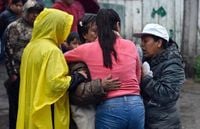When the skies opened over Mexico last week, few could have predicted the devastation that would follow. By Monday, October 13, 2025, the country was reeling from one of its most catastrophic bouts of torrential rain in recent memory, with at least 64 people confirmed dead and another 65 still missing, according to official figures cited by Reuters and the Associated Press. The deluge struck hardest in the states of Veracruz, Hidalgo, Puebla, Querétaro, and Nayarit, where swollen rivers and landslides swept away homes, roads, and, heartbreakingly, entire families.
The disaster began in earnest on Thursday, October 9, when a rain-swollen mountain river in Huauchinango, Puebla, overflowed its banks after dark. Within minutes, the river of mud and water had obliterated houses and left residents scrambling for their lives. Maria Salas, a 49-year-old cook from Huauchinango, lost five family members when their home collapsed. "I can't get my belongings, I can't sleep there. I have nothing," she told Agence France-Presse, echoing the trauma felt by countless others. Her own house was destroyed by a landslide, and she now shelters with what little she has left, watched over by soldiers guarding her devastated neighborhood.
The scale of destruction quickly became apparent. According to Mexico's Civil Protection agency, as reported by the Associated Press, the death toll included 29 in Veracruz, 21 in Hidalgo, 13 in Puebla, and one child in Querétaro. The hardest-hit regions, particularly along the Sierra Madre Oriental mountain range, saw entire communities cut off as landslides blocked roads and power outages severed communication lines. By Saturday, October 11, nearly 100 small communities remained uncontactable, complicating rescue and relief efforts. Even in larger towns like Huauchinango, with its 100,000 residents, access was severely restricted.
The meteorological roots of the disaster were complex. Meteorologist Isidro Cano explained to AFP that the intense rainfall was triggered by a seasonal shift and the collision of warm, humid air from the Gulf of Mexico with cold air fronts. This combination, coming at the tail end of an already saturated rainy season, proved disastrous. Admiral Raymundo Morales, Mexico's Navy secretary, elaborated that the convergence of hot and cold air over rivers already swollen from months of rain led to flooding on an unprecedented scale. As President Claudia Sheinbaum admitted to reporters, "This intense rain was not expected to be of such magnitude."
In Veracruz alone, as much as 21 inches (54 centimeters) of rain fell between Monday, October 6, and Thursday, October 9, according to federal government data. The relentless downpour caused rivers to burst their banks, submerging low-lying neighborhoods and turning streets into rivers of mud. Emergency responders, as documented by Reuters, waded through waist-deep water to rescue stranded residents and deliver supplies to isolated communities. In Jalcocotan, Nayarit, Mexican navy personnel worked tirelessly to remove mud from homes, while soldiers used backhoes to clear debris from devastated streets.
The human stories emerging from the disaster zone are as harrowing as they are heartbreaking. Rosalia Ortega, 76, stood near the lifeless body of her sister in Huauchinango, grateful at least to have found her for a proper burial. Petra Rodriguez, a 40-year-old domestic worker, described escaping with her family by holding hands—"so that if the water took one of us, it would take us all." Teacher Karina Galicia, 49, recounted how her family barely managed to flee their home before it was buried in mud. In less-damaged homes, neighbors banded together, using plastic bottles, brooms, and shovels to bail out the water, a testament to the resilience that communities often find in times of crisis.
Infrastructure across five states suffered severe damage. According to Reuters, more than 100,000 homes were affected, with bridges destroyed and streets left impassable by thick mud. Power outages were widespread but, as of October 13, electricity had been largely restored. Despite these efforts, approximately 65 people remain unaccounted for, and search operations have expanded to previously inaccessible areas. Civil Defense Coordinator Laura Velázquez Alzúa told the media that the government was scaling up its response, deploying thousands of personnel for evacuation, cleanup, and monitoring of the hardest-hit regions.
President Claudia Sheinbaum has been at the forefront of the response, convening governors from the affected states on October 12 and visiting disaster zones in Veracruz and Puebla. During a visit to a shelter in Huauchinango, she assured residents, "Everyone will get help to rebuild their homes," as reported by BBC News. She also met with the finance ministry to discuss funding for reconstruction and promised a rapid, coordinated government effort to address both immediate and long-term needs.
Yet, the challenges extend beyond the physical damage. Authorities are now focusing on containing the spread of mosquito-borne diseases such as dengue, which can thrive in the stagnant water left behind by floods. The psychological toll is also immense, with grieving families struggling to pay for funerals and salvage what remains of their lives. As Adriana Vazquez, 48, discovered when she climbed a path strewn with stones and mud to check on a relative's house, the destruction is often total—wood and tin homes leveled, and the familiar landscape unrecognizable.
While the immediate crisis response continues, the disaster has raised broader questions about preparedness and resilience in the face of increasingly extreme weather. The fact that the unnamed tropical depression struck at the end of the rainy season, when rivers and mountains were already saturated, caught many by surprise. As President Sheinbaum acknowledged, forecasters had been focused on tropical storms and hurricanes on the Pacific coast, leaving the Gulf region more vulnerable than anticipated.
As Mexico begins the long process of recovery, the resilience of its people is on full display. Neighbors help neighbors, emergency workers labor around the clock, and government officials pledge support even as the full scale of the tragedy continues to unfold. The hope, for many, is that lessons learned from this disaster will lead to stronger systems and infrastructure, better early warning, and a future where such heartbreak is less likely to be repeated.



